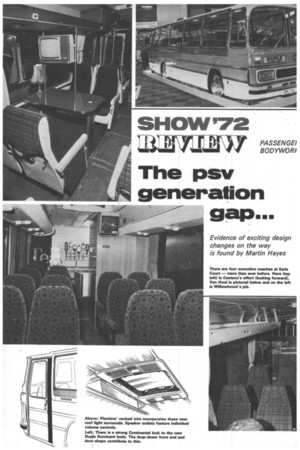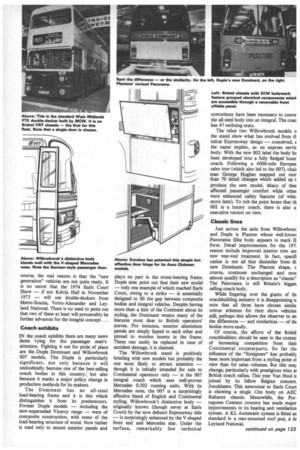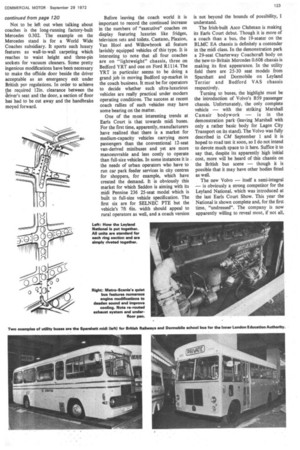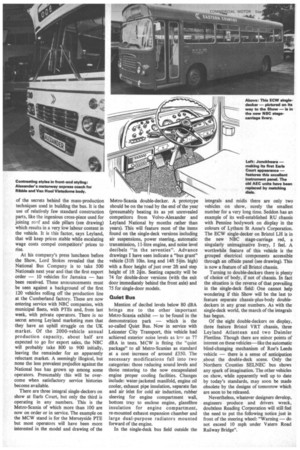The psv generation
Page 400

Page 401

Page 402

Page 405

Page 406

If you've noticed an error in this article please click here to report it so we can fix it.
.NTICIPATION is the keynote of the arls Court Show so far as passenger men re concerned. Despite several important ew models, particularly in the coach field, tere is a transitory theme to the Show in tat most manufacturers have many more ighly significant new vehicles under evelopment inadequately cloaked by a eil of secrecy. What is under the surface — nd just showing through with vehicles like le Leyland National — is nothing less than le next generation of passenger vehicles. The factors which are producing this new eneration — and some of the almost top-gap solutions on view now — are aried. They include the onset of British :ommon Market membership, increasing /odd concern and action about pollution nd safety and, most importantly, the hanging shape of Britain's public transport idustry. The devastating impact of the dvate car is taking its toll and operators, aced with still plummeting passenger eceipts despite severe operational ationalization, are demanding vehicles vhich are 100 per cent productive, offer nore passenger comforts and are totally :ost-effective.
Probably the main area where this can be .een at Earls Court is in the increase in the lumber of integral and semi-integral rehicles on show. The integral invasion may veil — as many people in the industry — sweep the entire British market.
But it has so far reached only the second stage of its march to power (the first was at Earls Court in 1970 with the debut of the Leyland National and Metro-Scania). The examples of the concept which are on show are merely forerunners of what is to follow. Most significant, perhaps, is that for the first time the integral idea has reached the coach market with the introduction of the Willowbrook-Mercedes. Certainly, this is only the first of many British coach designs based on integral construction.
But Earls Court '72 is not just about the giants of the industry who can benefit from the standardization imposed by integrals. For the past few years there has been a growing demand from rural and city-centre operators for vehicles in the 16to 30-seat class and it now appears that this market is being attacked in earnest.
About the sole field where development superficially appears to be almost at a standstill is in double-deckers — ironically just where the peak of demand is at present (though for how long is questionable). Of course, the real reason is that the "new generation" vehicles are not quite ready. It is no secret that the 1974 Earls Court Show — if not Kelvin Hall in November 1973 — will see double-deckers from Metro-Scania, Volvo-Alexander and Leyland National. There is no need to point out that two of these at least will presumably be further advances for the integral concept.
Coach exhibits IN the coach exhibits there are many news items 'vying for the passenger man's attention. Fighting it out for pride of place are the Duple Dominant and Willowbrook 007 models. The Duple is particularly significant, not only because it will undoubtedly become one of the best-selling coach bodies in this country,but also because it marks a major policy change in production methods for its makers.
The Dominant has an all-steel load-bearing frame and it is this which distinguishes it from its predecessors. Former Duple models — including the now-superseded Viceroy range — were of composite construction, with some of the load-bearing structure of wood. Now timber is used only to mount exterior panels and plays no part in the stress-bearing frame. Duple men point out that their new model — only one example of which reached Earls Court, owing to a strike — is essentially designed to fill the gap between composite bodies and integral vehicles. Despite having more than a hint of the Continent about its styling, the Dominant retains many of the features most dear to British operators' purses. For instance, exterior aluminium panels are simply lipped to each other and pinned to wooden inserts in the frame. These can easily be replaced in case of accident damage, it is claimed.
The Willowbrook stand is positively bristling with new models but probably the one most likely to attract attention — though it is initially intended for sale to Continental operators only — is the 007 integral coach which uses well-proven Mercedes 0.302 running units. With its Mercedes nose, the 007 is a surprisingly effective blend of English and Continental styling. Willowbrook's distinctive body — originally known (though never at Earls Court) by the now defunct Expressway title — is surprisingly enhanced by the V-shaped front end and Mercedes star. Under the surface, remarkably few technical contortions have been necessary to conve the all-steel body into an integral. The coac has 47 reclining seats.
The other two Willowbrook models o the stand show what has evolved from tf initial Expressway design — conceived, the name name implies, as an express servic body. With the new 002 label the body he been developed into a fully fledged luxur coach. Following a 4000-mile Europea sales tour (which also led to the 007), chait man George Hughes mapped out mor than 70 detail changes which added up t produce the new model. Many of thes affected passenger comfort while other were enhanced safety features (of whic more later). To rub the point home that th 002 is a luxury coach, there is also a executive version on view.
Classic lines Just across the aisle from Willowbroo. and Duple is Plaxton whose well-knowi .Panorama Elite body appears in mark II form. Detail improvements for the 197. season include improved interior trim aril new rear-end treatment. In fact, specifi cation is not all that dissimilar from th new Dominant. The Plaxton shape, c course, continues unchanged and mus almost qualify for a description as "classic' The Panorama is still Britain's bigges selling coach body.
While lingering over the giants of thi coachbuilding industry it is disappointing tx note that all three have chosen simila colour schemes for their show vehicles still, perhaps this allows the observer to se+ the differences — and similarities — of da bodies more easily.
Of course, the efforts of the Britisl coachbuilders should be seen in the contelc of increasing competition from theii Continental counterparts. So far tht
influence of the "foreigners" has probabb been more important from a styling point oi view than for sales volumes. But this ina. change, particularly with prestigious wins al British coach rallies. This year Van Hool is joined by its fellow Belgian concern, Jonckheere. This newcomer to Earls Court is showing a single 12m body on AEC Reliance chassis. Meanwhile, the Portuguese Caetano concern has made major improvements to its heating and ventilation system. A KL Automatic system is fitted as standard in a rear-mounted roof pod, a la Leyland National.
Not to be left out when talking about coaches is the long-running factory-built Mercedes 0.302. The example on the Mercedes stand is for a World Wide Coaches subsidiary. It sports such luxury features as wall-to-wall carpeting which reaches to waist height and three-pin sockets for vacuum cleaners. Some pretty ingenious modifications have been necessary to make the offside door beside the driver acceptable as an emergency exit under British psv regulations. In order to achieve the required 12in. clearance between the driver's seat and the door, a section of floor has had to be cut away and the handbrake moyed forward. Before leaving the coach world it is important to record the continued increase in the numbers of "executive" coaches on display featuring luxuries like fridges, television sets and toilets. Caetano, Plaxton, Van Hoot and Willowbrook all feature lavishly equipped vehicles of this type. It is interesting to note that all four coaches are on "lightweight" chassis, three on Bedford YRT and one on Ford R1114. The YRT in particular seems to be doing a grand job in moving Bedford up-market in the coach business. It must be for operators to decide whether such ultra-luxurious vehicles are really practical under modern operating conditions. The success at recent coach rallies of such vehicles may have some bearing on the matter.
One of the most interesting trends at Earls Court is that towards midi buses. For the first time, apparently, manufacturers have realized that there is a market for medium-capacity vehicles carrying more passengers than the conventional 12-seat van-derived minibuses and yet are more Manoeuvrable and less costly to operate than full-size vehicles. In some instances it is the needs of urban operators who have to run car park feeder services in city centres for shoppers, for example, which have created the demand. It is obviously this market for which Seddon is aiming with its midi Pennine 236 25-seat model which is built to full-size vehicle specification. The first six are for SELNEC PTE but the vehicle's 7ft 6in. width should appeal to rural operators as well, and a coach version is not beyond the bounds of possibility, I understand.
The Irish-built Asco Clubman is making its Earls Court debut. Though it is more of a coach than a bus, the 19-seater on the BLMC EA chassis is definitely a contender in the midi class. In the demonstration park a 29-seat Charterway Coachcraft body on the new-to-Britain Mercedes 0.608 chassis is making its first appearance. In the utility field there are 25-30 seat models from Sparshatt and Dormobile on Leyland Terrier and Bedford VAS chassis respectively.
Turning to buses, the highlight must be the introduction of Volvo's B59 passenger chassis. Unfortunately, the only complete vehicle — with the striking Marshall Camair bodywork — is in the demonstration park (leaving Marshall with only a rather basic body for Lagos City Transport on its stand). The Volvo was fully described in CM September 1 and it is hoped to road test it soon, so I do not intend to devote much space to it here. Suffice it to say that, despite its apparently high initial cost, more will be heard of this chassis on the British bus scene — though it is possible that it may have other bodies fitted as well.
The new Volvo — itself a semi-integral — is obviously a strong competitor for the Leyland National, which was introduced at the last Earls Court Show. This year the National is shown complete and, for the first time, "undressed". The company is now apparently willing to reveal most, if not all, of the secrets behind the mass-production techniques used in building the bus. It is the use of relatively few standard construction parts, like the ingenious cross-piece used for joining roof and side pillars (see drawing) which results in a very low labour content in the vehicle. It is this factor, says Leyland, that will keep prices stable while escalating wage costs compel competitors' prices to rise.
At his company's press luncheon before the Show, Lord Stokes revealed that the National Bus Company is to take 500 Nationals next year and that the first export order — 10 vehicles for Jamaica — has been received. These announcements must be seen against a background of the first 120 vehicles rolling off the production line at the Cumberland factory. These are now entering service with NBC companies, with municipal fleets, with PTEs and, from last week, with private operators. There is no secret among Leyland marketing men that they have an uphill struggle on the UK market. Of the 2000-vehicle annual production capacity, about half are expected to go for export sales, the NBC will probably take 800 to 900 initially, leaving the remainder for an apparently reluctant market. A seemingly illogical, but none the less prevalent prejudice against the National bus has grown up among some operators. Presumably this will be overcome when satisfactory service histories become available.
There are three integral single-deckers on show at Earls Court, but only the third is operating in any numbers. This is the Metro-Scania of which more than 100 are now on order or in service. The example on the MCW stand is for the Merseyside PTE but most operators will have been more interested in the model and drawing of the Metro-Scania double-decker. A prototype should be on the road by the end of the year (presumably beating its as yet unrevealed competitors from Volvo-Alexander and Leyland National by months rather than years). This will feature most of the items found on the single-deck versions including air suspensions, power steering, automatic transmission, 11-litre engine, and noise level decibels "in the seventies". Advance drawings I have seen indicate a "bus grant" vehicle (31ft 10in. long and 14ft 5+in. high) with a floor height of just over 2ft and step height of 1ft 2-tin. Seating capacity will be 74 for double-door versions (with the exit door immediately behind the front axle) and 75 for single-door models.
Quiet Bus
Mention of decibel levels below 80 dBA brings me to the other important Met ro-Scaniaexhibit — to be found in the demonstration park — which is the so-called Quiet Bus. Now in service with Leicester City Transport, this vehicle had achieved exterior noise levels as low as 77 dBA in tests. MCW is fitting the "quiet package" to all Metro-Scanias as standard at a cost increase of around 050. The necessary modifications fall into two categories: those reducing sound levels and those restoring to the now encapsulated engine proper cooling facilities. Changes include: water-jacketed manifold, engine oil cooler, exhaust pipe insulation, separate fan and air inlet for cold air induction, rubber sleeving for engine compartment wall, bottom tray to enclose engine, glassfibre insulation for engine compartment, re-mounted exhaust expansion chamber and large dual-purpose radiators mounted forward of the engine.
In the single-deck bus field outside the integrals and midis there are only two vehicles on show, surely the smallest number for a very long time. Seddon has an example of its well-established RU chassis with Pennine bodywork on display in the colours of Lytham St Anne's Corporation. The ECW single-decker on Bristol LH is in the new NBC stage-carriage red, a singularly unimaginative livery, I feel. A worthwhile feature of this vehicle is the grouped electrical components accessible through an offside panel (see drawing). This is now a feature of all Bristol chassis.
Turning to double-deckers there is plenty of choice of body, if not of chassis. In fact the situation is the reverse of that prevailing in the single-deck field: One cannot help wondering if this Show will be the last to feature separate chassis-plus-body doubledeckers in any great numbers. As with the single-deck world, the march of the integrals has begun.
Of the eight double-deckers on display, three feature Bristol VRT chassis, three Leyland Atlantean and two Daimler Fleetline. Though there are minor points of interest on these vehicles—like the automatic blind-changing mechanism of Roe's Leeds vehicle — there is a sense of anticipation _about the double-deck scene. Only the Northern Counties SELNEC bus shows any spark of imagination. The other vehicles on show, while apparently well up to date by today's standards, may soon be made obsolete by the designs of tomorrow which are soon to be released.
Nevertheless, whatever designers develop, engineers produce and drivers wreck, doubtless Reading Corporation will still feel the need to put the following notice just in front of the steering wheel: "Warning — do not exceed 10 mph under Vatern Road Railway Bridge".
































































































































































































































































































































































































































































































































